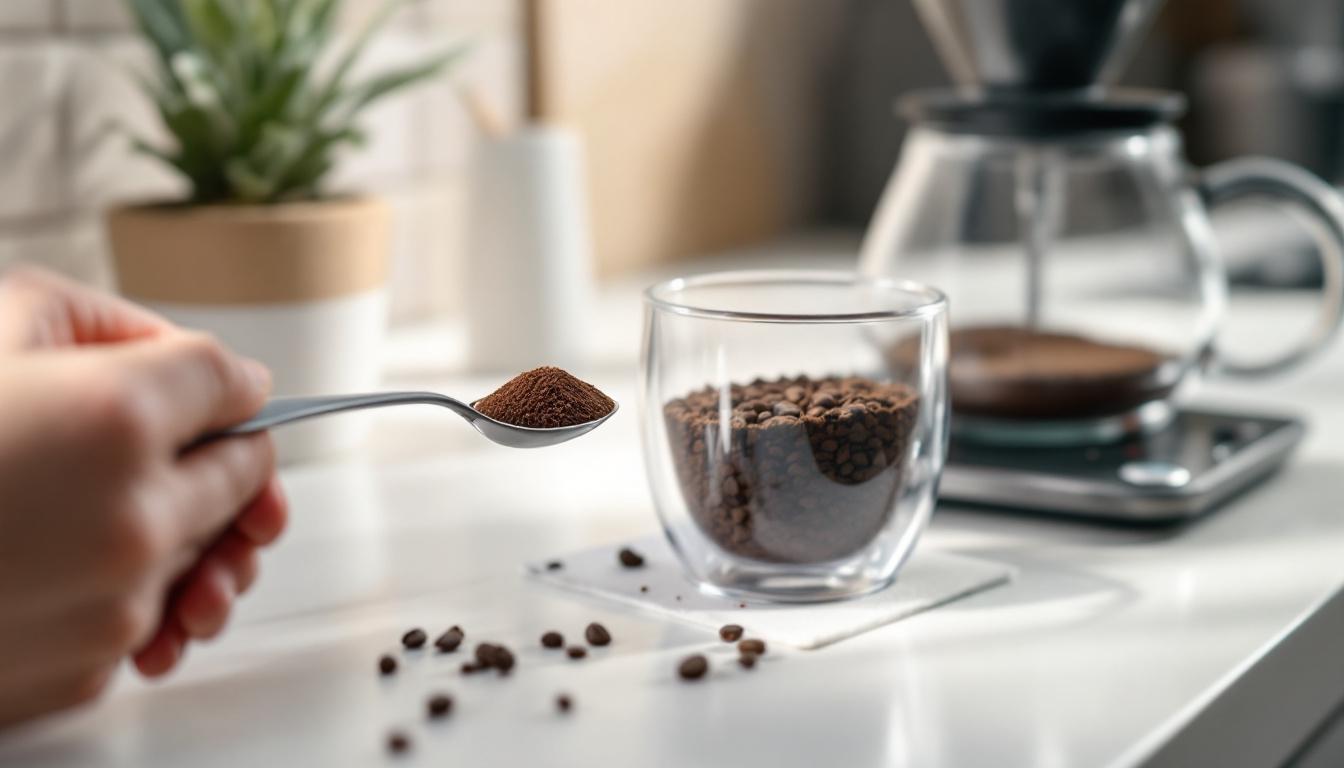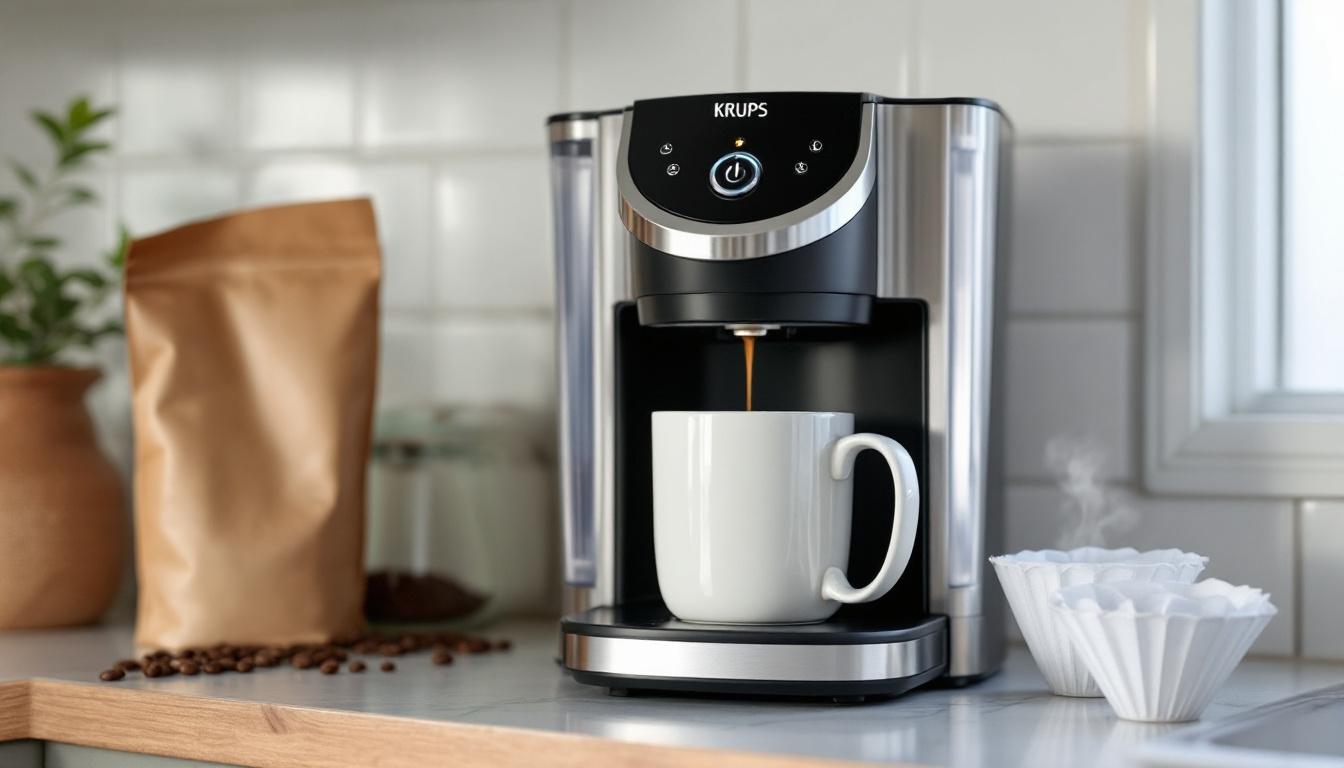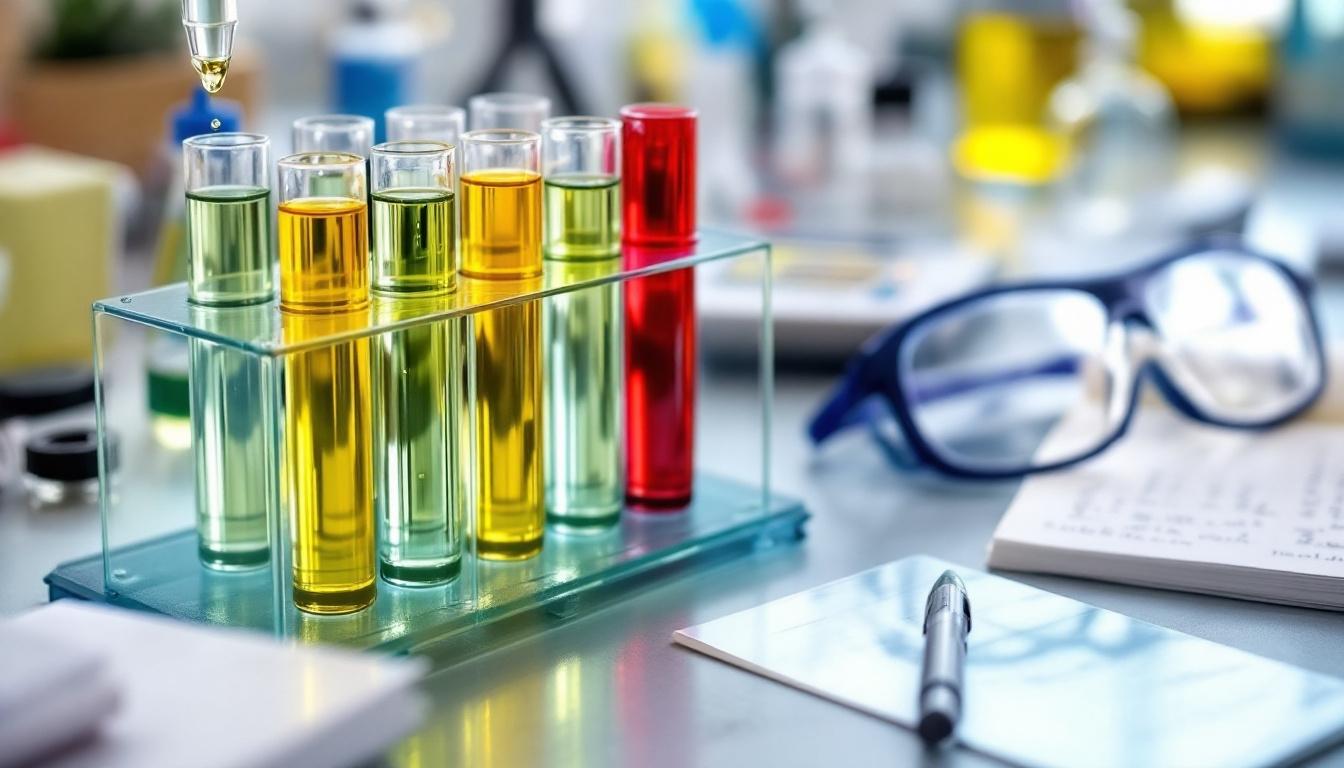At Ultimate Treat, we know that brewing the perfect cup of coffee starts with the right measurements. Many coffee lovers struggle with determining how many tablespoons of coffee per cup they should use when brewing.
This guide will help you master the art of coffee-to-water ratios, explore different brewing methods, and fine-tune your coffee strength to match your taste preferences.
What’s the Perfect Coffee-to-Water Ratio?
The Golden Standard
At Ultimate Treat, we believe that the perfect cup of coffee starts with the right coffee-to-water ratio. The Specialty Coffee Association (SCA) recommends a brew strength, measured in Total Dissolved Solids, of 11.5 to 13.5 grams per litre, corresponding to 1.15 to 1.35 percent. This serves as an excellent starting point for most brewing methods.
Translating to Tablespoons
For those who prefer measuring in tablespoons, Counter Culture Coffee suggests using 1 tablespoon of coffee for every 4 ounces of water. However, tablespoon measurements can lack consistency due to variations in grind size and coffee density. For precise results, we recommend using a kitchen scale.
Adjusting for Different Brewing Methods
Different brewing techniques may require slight adjustments to the standard ratio:
- French Press: Use a slightly higher ratio (1:15 or 1:16) to account for the full immersion brewing process.
- Pour-Over: A 1:17 ratio often works well due to the continuous water flow through the grounds.
- Espresso: Requires a much higher concentration, typically around 1:2 or 1:3.
Factors Influencing the Ideal Ratio
Several elements can affect the perfect coffee-to-water ratio:
- Roast Level: Darker roasts often require less coffee due to their intense flavour profile.
- Grind Size: Finer grinds extract more quickly (potentially requiring less coffee).
- Water Temperature: Hotter water extracts faster, which might influence the amount of coffee used.
- Personal Preference: Some coffee enthusiasts prefer stronger brews, while others enjoy milder flavours.
Experimenting for Your Perfect Cup
We encourage you to experiment with these ratios. Start with the standard ratio and adjust based on your taste preferences. Try keeping a brewing journal to track your experiments and find your ideal cup. Our Ultimate Treat coffee blend shines in various ratios and brewing methods, so don’t hesitate to fine-tune your approach.
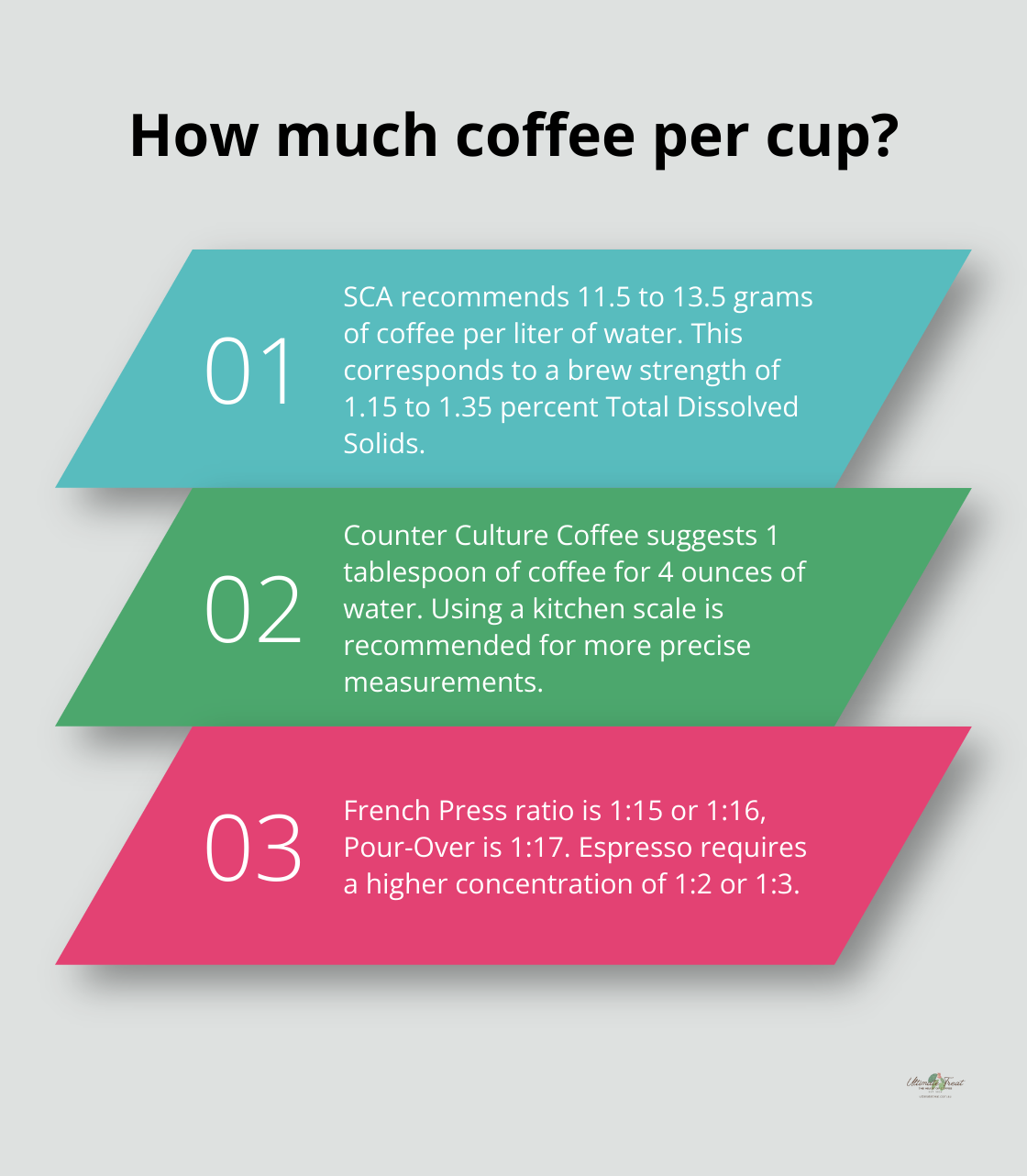
As you progress in your coffee journey, you’ll want to explore how these ratios apply to different brewing methods. Let’s examine how to measure coffee for various popular brewing techniques.
How to Measure Coffee for Popular Brewing Methods
Drip Coffee Makers
For drip coffee makers, use 1 to 2 tablespoons of ground coffee per 6 ounces of water. This ratio works well for most standard drip machines. A 12-cup coffee maker requires about 12–24 tablespoons of coffee. (Most drip coffee makers consider a “cup” to be 5-6 ounces, not 8 ounces.)
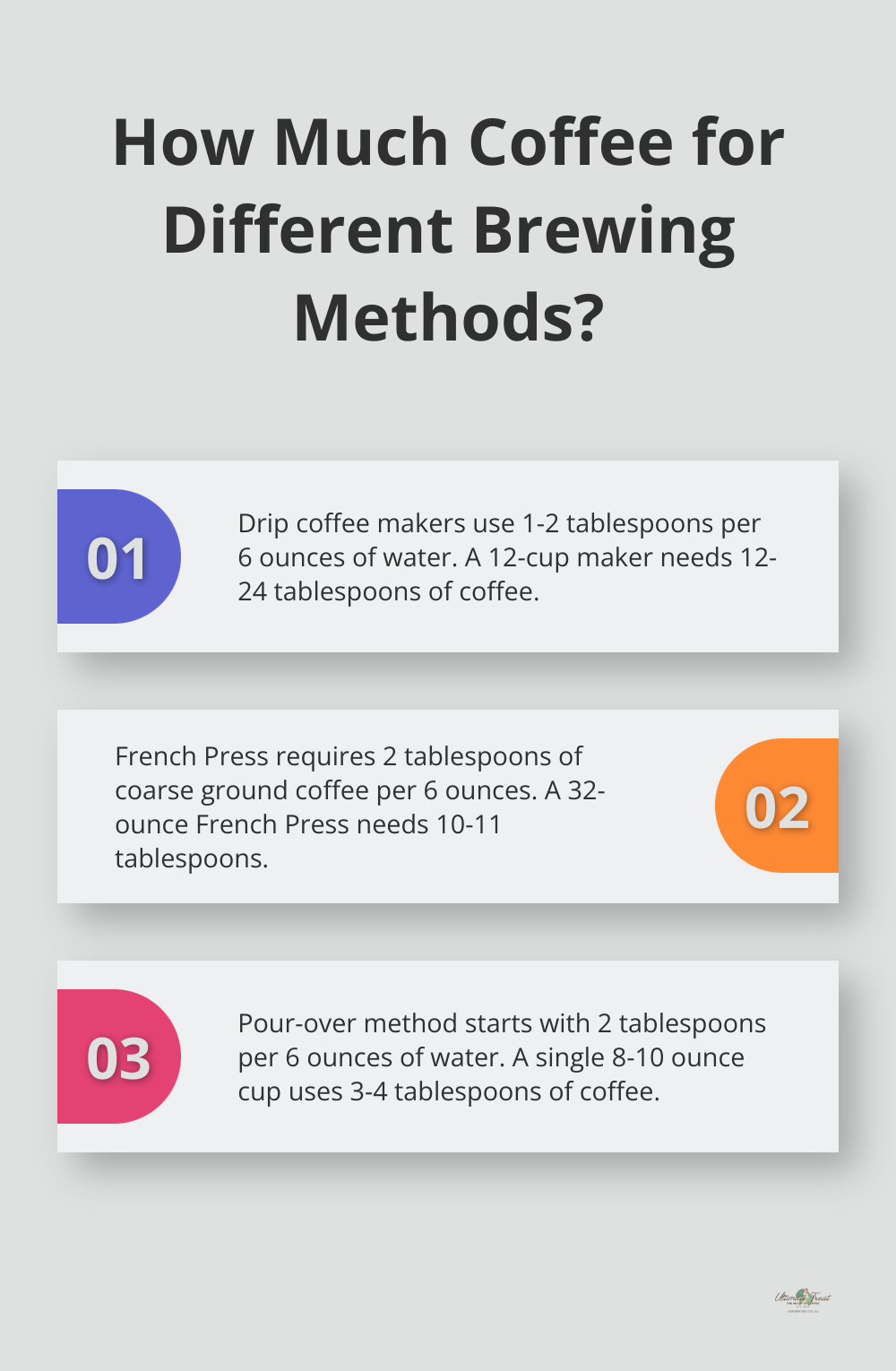
For precision, try a kitchen scale. Use 14 grams of coffee per 8 ounces of water. This method ensures consistency, especially when switching between different coffee brands or roasts.
French Press
French Press brewing requires a coarser grind and a slightly higher coffee-to-water ratio. Use 2 tablespoons of coarsely ground coffee per 6 ounces of water. A standard 32-ounce French Press needs about 10-11 tablespoons of coffee.
If measuring by weight, use 7g of coffee per 100ml of water. This ratio allows for full flavour extraction during the 4-minute steeping process typical for French Press brewing.
Pour-Over Method
Pour-over brewing offers excellent control over the extraction process. Start with 2 tablespoons of medium-fine ground coffee per 6 ounces of water. For a single cup (8-10 ounces), use 3-4 tablespoons of coffee.
When using a scale, try a 1:17 ratio of coffee to water. For example, for a 12-ounce cup, use 20 grams of coffee and 340 grams of water. This ratio creates a clean, bright cup that highlights the coffee’s nuanced flavours.
Espresso
Espresso requires a fine grind and a much higher coffee-to-water ratio. For a single shot (1 ounce), use 6-8 grams of finely ground coffee. A double shot (2 ounces) typically requires 14-18 grams of coffee.
These measurements are important for espresso, as even small variations can significantly affect the taste. Most home espresso machines come with a portafilter basket sized for either single or double shots, which simplifies measurement.
Now that we’ve covered the measurements for various brewing methods, let’s explore how to adjust coffee strength to match your personal preferences.
How to Customize Your Coffee Strength
Adjusting Coffee-to-Water Ratios
The first step to customise your coffee strength involves adjusting the coffee-to-water ratio. For a stronger cup, use a ratio of 1:15, or if you want a lighter cup, use 1:18. Somewhere between 15 to 18 grams of water to every gram of coffee is a good starting point.
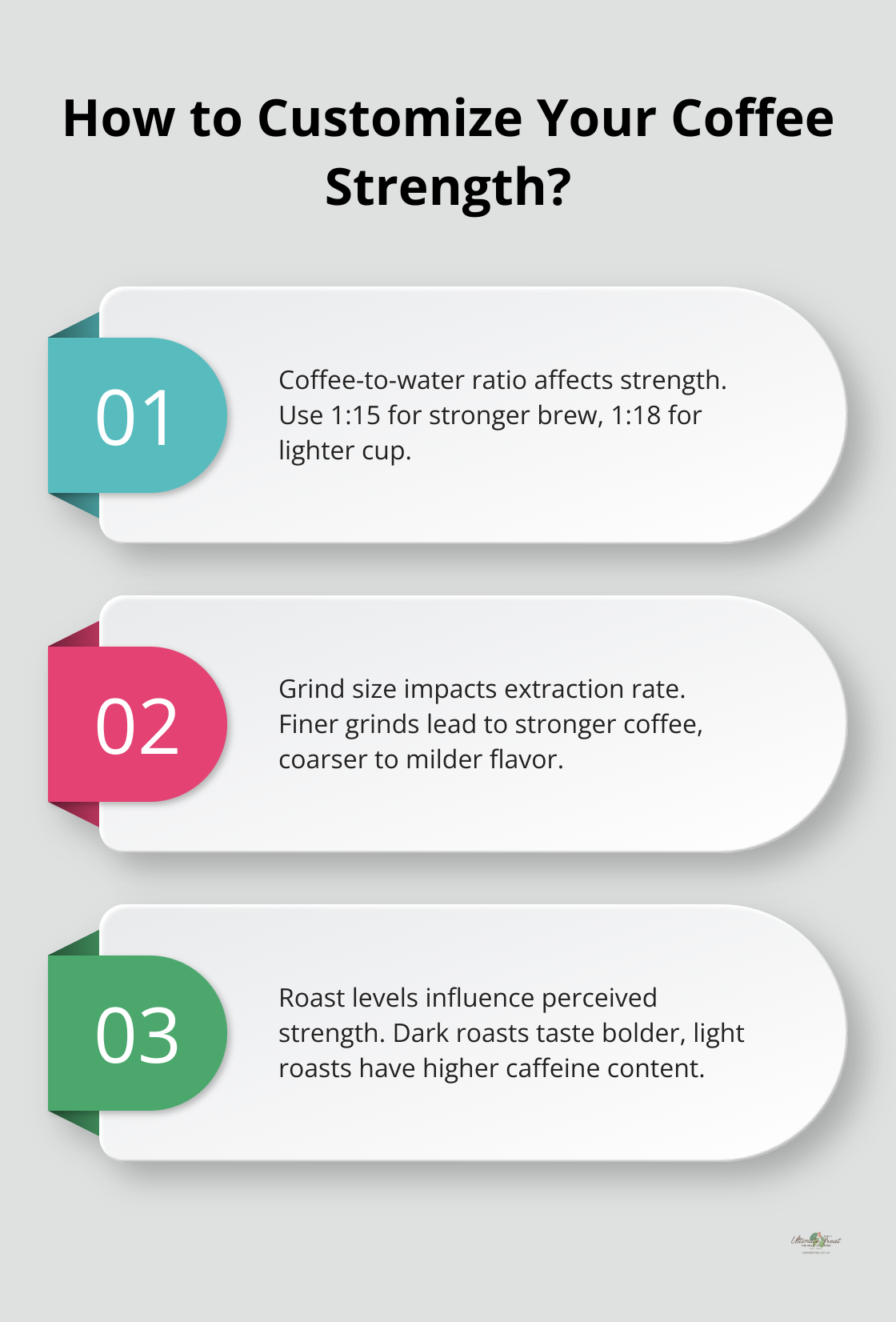
Track your experiments in a brewing journal. Note the ratio used, the resulting taste, and your satisfaction level. This will help you identify your preferred strength over time.
Understanding Grind Size Impact
Grind size significantly affects coffee strength. The finer you grind your coffee beans, the more you increase the exposed surface area of the grounds, resulting in faster extraction. That’s why finer grinds can lead to stronger coffee.
For pour-over methods, a slightly finer grind can create a stronger cup, while a coarser grind produces a milder flavour. French press typically requires a coarser grind, but experimenting with slightly finer grinds can increase strength without introducing bitterness.
Changing grind size may require you to adjust your brewing time. Finer grinds typically need less contact time with water to avoid over-extraction.
Exploring Roast Levels
The roast level of your coffee beans significantly affects the perceived strength of your brew. Darker roasts often taste “stronger” due to their bold, intense flavours (while lighter roasts can seem milder but often have higher caffeine content).
If you prefer a bold taste but find dark roasts too intense, try a medium-dark roast with a slightly higher coffee-to-water ratio. This can provide a strong flavour without the potential bitterness of very dark roasts.
For those who enjoy the complex flavours of lighter roasts but want a stronger cup, increase your coffee-to-water ratio slightly. This allows you to maintain the unique taste profile of the beans while boosting overall strength.
Considering Brewing Methods
Different brewing methods can affect the perceived strength of your coffee. For example, the French press tends to produce a fuller-bodied cup compared to drip coffee makers. Espresso machines create a highly concentrated shot, while cold brew often results in a smooth, less acidic flavour.
Try experimenting with various brewing methods to find the one that best suits your strength preferences. (You might discover that you prefer milder coffee from a pour-over method or a stronger brew from a French press.)
Balancing Flavour and Strength
As you customize your coffee strength, pay attention to the overall flavour profile. Stronger doesn’t always mean better. Try to find a balance between strength and flavour that satisfies your palate.
Consider factors like acidity, bitterness, and sweetness as you adjust your brew. (A perfectly strong cup should still highlight the unique characteristics of the coffee beans.)
Final Thoughts
Brewing coffee with the right number of tablespoons per cup combines art and science. We explored various methods and ratios, from 1-2 tablespoons per 6 ounces of water for drip coffee to more concentrated measurements for espresso. Consistency proves the key to achieving your perfect cup. You’ll reach coffee nirvana if you maintain a steady ratio and adjust based on your preferences.

Experimentation leads to your ideal brew. You should tweak your measurements, try different grind sizes, and explore various roast levels. Your taste buds guide you, so trust them and enjoy perfecting your brew. What works for one coffee enthusiast might not work for another (but that’s part of the fun).
At Ultimate Treat, we value quality ingredients in crafting the perfect cup. Our premium organic coffee blend shines across various brewing methods and ratios. You’ll find joy in your cup, whether you prefer strong, bold flavours or milder, nuanced tastes. Happy brewing!

